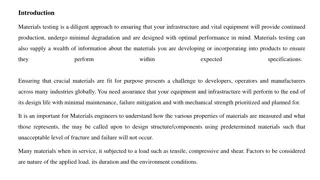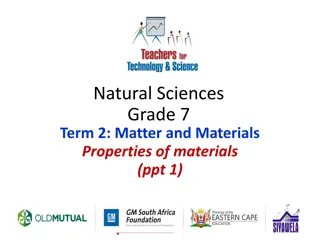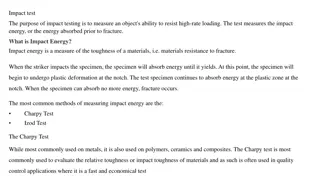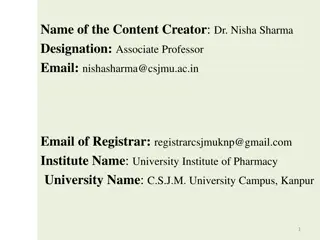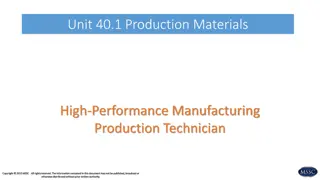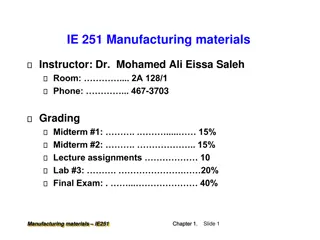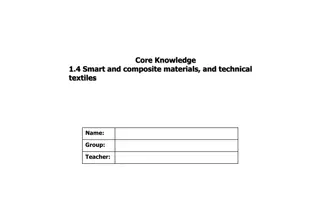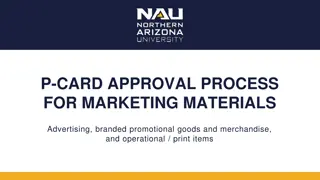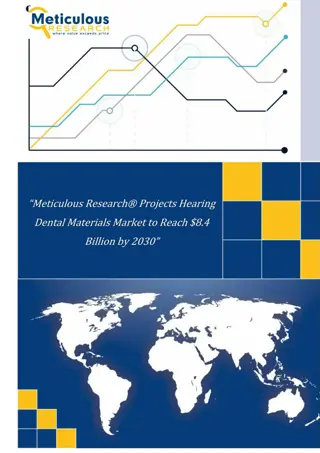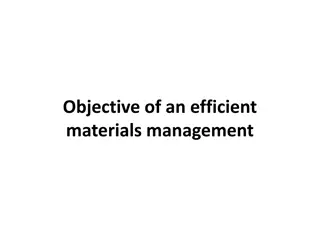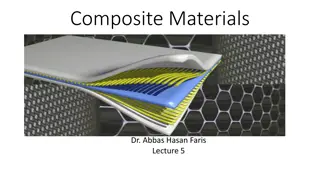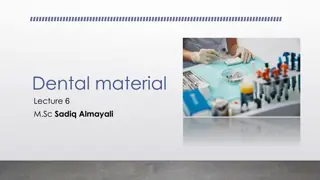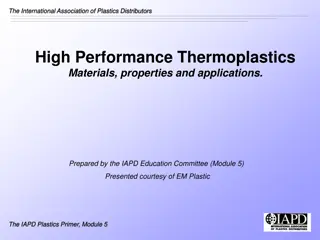Florida Statewide Assessments - Summer 2023 Overview
Training materials for the Summer 2023 Florida Statewide Assessments in Miami-Dade County Public Schools, focusing on test administration policies and procedures. The materials are based on the Spring/Summer 2023 Test Administration Manual and cover important information related to test administrati
0 views • 69 slides
Understanding Solid State Chemistry: Amorphous vs. Crystalline Solids
Solid state chemistry involves studying the differences between amorphous and crystalline solids, exploring their unique properties such as melting points, isotropic/anisotropic characteristics, and examples of each type of solid. Additionally, the classification of crystals into different crystal s
7 views • 62 slides
Understanding Crystal Structures and Types of Solids in Materials Science
Crystal structures in materials science involve the arrangement of atoms in solids, with examples of crystalline and amorphous solids like metals and glass. Explore concepts like energy packing, definitions of crystalline materials, unit cells, BCC and FCC lattices, HCP structures, and Miller Indice
10 views • 12 slides
Module C1:Material substitution.
Explore the concept of material substitution in the context of circular economy principles for energy storage. Understand the importance of material availability, limitations of secondary raw materials in energy applications, and classification of energy conversion and supportive materials. Discover
5 views • 16 slides
Comprehensive Industrial Wood Construction Education Materials for 2022
Extensive teaching materials for industrial wood construction education in 2022, prepared by various educational institutions and industry experts. The materials cover topics such as construction economy, project management, and specialized knowledge on wood construction. Students will gain insights
2 views • 32 slides
Significance of Raw Materials in Food Processing
Effective selection of raw materials is crucial for ensuring the quality of processed food products. The quality of raw materials directly impacts the final products, making it important to procure materials that align closely with processing requirements. Quality evaluation, including microbiologic
2 views • 30 slides
Understanding Dental Impression Materials and Techniques
Dental impression materials are essential in dentistry to create precise negative records of the oral tissues. The process involves obtaining a negative impression and then producing a positive reproduction using materials like dental stone. These materials must meet specific desirable properties to
1 views • 18 slides
Understanding Composite Materials: Properties and Applications
Composite materials are combinations of chemically distinct substances that offer improved properties over individual materials. They can be natural or synthetic, with examples like wood and bamboo. Composites consist of reinforcing fibers or particles embedded in a matrix material. Smart materials,
1 views • 9 slides
Understanding Resins: Composition, Occurrence, and Classification
Resins are solid/semisolid amorphous products with complex chemical composition and are found in plants, animals, and fossils. They contain essential oils, terpene products, and carboxylic acids. Resins occur as a result of normal metabolism or in response to injury, forming physiological or patholo
1 views • 37 slides
Understanding the Importance and Methods of Materials Testing
Ensuring materials in infrastructure and equipment meet performance standards is crucial for sustainable production. Materials testing, encompassing destructive and non-destructive methods, provides valuable insights into material properties. From tensile to compression tests, understanding stress a
4 views • 28 slides
Understanding Thermal Properties of Materials
Materials respond differently to heat based on their thermal properties such as heat capacity, thermal expansion, conductivity, and shock resistance. The ability of materials to absorb heat, expand with temperature changes, and conduct heat varies across ceramics, metals, and polymers. Heat capacity
0 views • 19 slides
Understanding Physical Properties of Materials in Grade 7 Natural Sciences
Exploring the physical properties of materials like strength and flexibility helps us decide which materials to use for specific purposes. Strong materials like steel and concrete are used in construction, while flexible materials like rubber and copper wire have different applications. Consideratio
1 views • 17 slides
Understanding Impact Testing for Materials Evaluation
Impact testing is crucial for assessing the toughness and resistance of materials to fracture under high-rate loading conditions. Charpy and Izod tests are common methods used to measure impact energy and evaluate materials' performance. The tests involve striking a specimen with a striker and measu
2 views • 13 slides
Understanding Resins in Pharmacognosy: Properties and Occurrence
Resins are solid or semi-solid amorphous products rich in carbon atoms, found in plants, animals, and fossils. They contain essential oils, terpenes, and carboxylic acids. Resins have unique chemical and physical properties and are secreted in specialized structures like resin cells and glandular ha
0 views • 11 slides
Engineering Materials and Production Techniques Overview
Learn about the various types of engineering materials used in high-performance manufacturing, including natural and synthetic materials. Explore the properties of materials, such as strength, conductivity, and resistance. Discover the different categories of metals, alloys, and polymers commonly ut
0 views • 19 slides
Understanding Viscoelasticity and Relaxation in Amorphous Materials
Dive into the world of viscoelasticity and relaxation in amorphous materials, exploring concepts like complex shear modulus, Maxwell element, and phenomenological models. Discover the intriguing nature of glass, its transition between solid and viscous states, and the various theories surrounding it
1 views • 34 slides
Hazardous Materials Business Plan Training Program
Facilities subject to the Hazardous Materials Business Plan (HMBP) Program must implement a training program for employees on hazardous materials safety and emergency response. This includes initial training for new employees within 30 days of hire and annual refresher training. Training covers safe
1 views • 73 slides
Channeling 2014 - Summary of Hybrid Positron Source and Crystal Undulator Workshop
In Channeling 2014, a workshop was held discussing topics such as the hybrid positron source with granular converter, crystal undulator, and parametric X-ray radiation. The workshop presented the concept of a crystal radiator providing photons and an amorphous converter for positron production. Tech
0 views • 18 slides
Materials Science: Revolutionizing Innovation in the Next Decade
Materials science is poised to be the cornerstone of technological advancements in the next decade, addressing challenges such as clean energy, product innovation, and material supply disruptions. Scientists are leveraging advanced simulation techniques and machine learning to accelerate materials r
2 views • 15 slides
IE 251 Manufacturing Materials Course Overview
Explore the impact of modern materials on daily products, understand engineering materials and their properties, and delve into classes of materials like metals, polymers, ceramics, and composites. The course covers topics ranging from atomic structure to phase transformations, emphasizing the role
0 views • 14 slides
Understanding Materials Science and Engineering Fundamentals
Materials play a crucial role in our daily lives, influencing everything from transportation to communication. This lecture delves into the historical significance of materials, the distinctions between materials science and materials engineering, and the importance of structure-property correlation
1 views • 25 slides
National Academy of Engineering and Materials Science Insights
The National Academy of Engineering (NAE) and National Materials and Manufacturing Board (NMMB) provide expert advice on pressing challenges, promoting a vibrant engineering profession, and advancing technology. The NMMB focuses on materials science for engineering innovations, offering independent
1 views • 13 slides
Exploring Materials in Everyday Objects
Discover the suitability of different materials for specific uses through fun activities like a spoon race with various spoon materials. Explore why certain materials are not appropriate for certain objects and engage in creative tasks like imagining a spoon made of tissue paper. Michael Rosen's whi
0 views • 6 slides
Exploring Smart and Composite Materials in Modern Technology
The content delves into the realm of smart and composite materials, highlighting modern advancements and applications such as shape-memory alloys, nanomaterials, photochromic glass, temperature-responsive polymers, and more. It discusses the advantages, disadvantages, and examples of composites like
0 views • 11 slides
University P-Card Approval Process for Marketing Materials
Explore the University P-Card approval process for purchasing marketing materials such as advertising, branded promotional goods, and operational/print items. Learn what items are considered marketing materials, who to contact for purchase, and the procedures for reconciliation. Find out how to buy
0 views • 10 slides
Expanding Your Vocabulary: Unit 4 Key Words Explained
Gain insight into essential vocabulary words from Unit 4 with clear definitions, synonyms, and example sentences. Enhance your language skills as you learn about words like "affable," "aggrandize," "amorphous," "archetype," "aura," "contraband," "erudite," and "gossamer.
0 views • 21 slides
Dental Materials Market
The dental materials market is categorized based on type\u2014comprising Indirect Restorative Materials (metal-ceramics, ceramics, and other indirect materials), Direct Restorative Materials (amalgam, resin-based composites, glass ionomer, and other
0 views • 4 slides
Forest Service Policy on Native Materials in Wilderness
This information outlines the use of native materials in wilderness areas, focusing on trails, bridges, and administrative facilities. It covers examples of structures using native materials, common questions surrounding material choices, guidelines for trail and wilderness managers, and Forest Serv
0 views • 31 slides
Enhancing Accessible Educational Materials for Physical/Health Disabilities
Specialist Chris Kuehl discusses the importance of accessible educational materials for individuals with physical/health disabilities. Explore resources like the National Center on Accessible Educational Materials, AIM, NIMAC, AEM, and more. Learn how to request specialized formats when purchasing n
0 views • 10 slides
Understanding Raw Materials in Ceramic Production
Raw materials play a crucial role in ceramic production, with three main groups identified - plastic materials like clay, non-plastic or leading mixtures such as silica, and fluxes/mineralizers like feldspar. These materials undergo various transformations during the manufacturing process, contribut
0 views • 29 slides
Understanding X-Ray Diffraction Techniques in Materials Science
X-ray diffraction (XRD) analysis is a crucial technique in materials science for determining the crystallographic structure of materials. By irradiating a material with X-rays and measuring their intensities and scattering angles, XRD helps identify materials based on diffraction patterns. This meth
0 views • 5 slides
Efficient Materials Management Strategies for Optimal Operations
Efficient materials management aims to ensure the right materials are available at the right place, time, quantity, and quality. It involves stages such as precise objective definition, specification of requirements, and measurement of performance. Factors influencing materials management include te
0 views • 20 slides
Understanding Types of Language Teaching Materials
Explore the various types of language teaching materials, including authentic and non-authentic materials, pedagogical resources, and created materials. Learn about the characteristics of authentic material and its advantages in language learning. Discover examples of authentic materials such as son
0 views • 22 slides
Evolution of Materials Science and Engineering in Human History
Explore the journey of materials in human history, from traditional ceramics to high-tech metal industry and beyond. Learn about the development of materials science and engineering, the different properties of materials, and the classification of materials into metals, ceramics, polymers, composite
0 views • 9 slides
Understanding Composite Matrix Materials in Engineering
Composite materials are made of reinforcing fibers and matrix materials, with the matrix serving to protect and enhance the properties of the composite. There are three main types of composite matrix materials: metal matrix composites (MMC), ceramic matrix composites (CMC), and polymer matrix compos
0 views • 22 slides
Understanding the Classification of Magnetic Materials
The origin of magnetism lies in the orbital and spin motions of electrons, determining the magnetic properties of different materials. All matter is magnetic to some extent, with substances exhibiting diamagnetism, paramagnetism, or ferromagnetism. Diamagnetic materials oppose applied magnetic field
0 views • 24 slides
Understanding Rheology in Dental Materials
Rheology is a crucial aspect in dentistry as it deals with the flow properties of various dental materials, including liquids like molten alloy and impression materials. Viscosity plays a key role, determining how materials flow and behave. Different fluid classifications based on rheology, such as
0 views • 15 slides
Understanding High Performance Thermoplastics: Materials, Properties, and Applications
Explore the various types of high-performance thermoplastics, including their key characteristics and applications. From semi-crystalline to amorphous plastics, learn about their costs, strengths, electrical properties, chemical resistance, and more. Discover the differences between amorphous and se
0 views • 40 slides
Understanding Solid State Chemistry: Principles and Classification of Solids
Solid State Chemistry (CHEM 422) explores the principles and concepts governing the synthesis, structure, bonding, reactivity, and properties of solid state materials. The course delves into crystalline vs. amorphous solids, highlighting categories like ionic, molecular, metallic, and covalent solid
0 views • 24 slides
Understanding Insulating Materials for Energy Efficient Buildings
Insulating materials play a crucial role in maintaining energy efficiency in buildings. This presentation covers the classification of insulating materials based on solid structure nature - mineral, vegetal, and synthetic. It explores the properties and applications of different types of insulating
0 views • 41 slides









